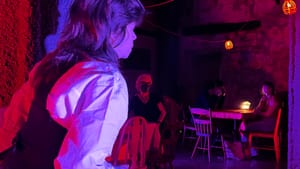Stay in the Loop
BSR publishes on a weekly schedule, with an email newsletter every Wednesday and Thursday morning. There’s no paywall, and subscribing is always free.
An undercooked dramatic menu
Big Telly and Tiny Dynamite present The Worst Café in the World

Most shows, as the audience enters, will welcome you with a program or a playbill. The Worst Café in the World instead offers a menu. Rather than a set course of theatrical entertainment, this dinner service is à la carte, all “dishes” made to order and performed by the café’s three hosts. Like many an outré dining experience, it has the allure of the new, but the glow begins to fade somewhere around the second course, as you realize much of the food is woefully undercooked.
Developed by Zoe Seaton and KC MacMillan in a collaboration between Big Telly and Tiny Dynamite, The Worst Café in the World takes you to a restaurant in a clandestine location, accessible only via password and secret knock. The show is getting its North American premiere, and this production debuted Off-Broadway earlier in April; now it’s landing at a Philly brewery.
The year is 2030, and it seems our decade has culminated in a vaguely fascist dystopia (“All culture has been canceled,” reads a note that we’re instructed immediately to destroy). Art, therefore, survives only in illicit pockets, such as in this particular eatery, where vignettes and monologues are presented through a series of menus: starters, small plates, and the chef’s tasting menu. The starters make a bold first impression, but by the time we reach the tasting menu, the conceit has worn thin, unsure of what it wants to say.
Clowning and classics
The starters unfold in a smattering of clownish chaos, performed as endurance sport by our three hosts (Anna Faye Lieberman, Gabe Moses, and David Pica). All the dishes here are quick bits, overlapping in rapid succession, some sketches in miniature and others simple puns. If you order a Dramatic Exit, you get exactly that, whereas an Apple Turnover comprises an apple placed on the table before you, then turned upside down. Several items include light and sound cues that are executed with swift precision (lights by Andrew Cowles, sound by Chris Kilcullen).
All this excitement is presented as prologue to the main course, but oddly, from here, the tempo subsides. Where the starters are rowdy clown, the small plates and tasting menu are straightforward classic theater in broad American style, scenes presented in their most literal forms. The Greek Mezze Platter is Antigone, the Scottish Dish (We Can’t Say Its Name) is Macbeth, etc. The actors do a fine job with the material—Shakespeare sturdily intoned, Cabaret suavely belted—but the show is uninterested in the performers as characters, so we simply have these performances in a vacuum. Without any connective tissue, it can’t help but come across as a sequence of actors in an audition room, each equipped with their monologue of choice.
Unanswered questions
The show’s conceit thus culminates in what must be its blandest possible interpretation, theater-as-dinner that presents a straightforward assemblage of classic theater and incorporates audience interaction as a halfhearted shrug. Along the way, the show never engages with the obvious questions it raises. Why, for instance, has theater taken this truncated form? What dystopia would compel this style of presentation? And why is this the “worst” café in the world? At first, the details seem purposefully shadowy, but it soon becomes clear that these are questions that the show hasn’t considered for itself, details left incongruous and ultimately sloppy. It’s one thing if this world is vague to the audience, but another entirely if the performers are also in the dark.
The past decade has seen a panoply of rich work considering art in the apocalypse, from the motley evolution of Shakespeare in Station Eleven to the radical reinvention of The Simpsons in Mr. Burns, a Post-Electric Play. It’s important to remember why these pieces work, how they show our culture take strange and unfamiliar shapes, the contours of such art reflecting the contours of a new world. Otherwise, we’ll be left with flavors thrown together in a homogenous paste, in an evening that promises dinner and a show but never provides much of either.
What, When, Where
The Worst Café in the World. By Zoe Seaton and KC MacMillan. $25. Through May 5, 2024, at Poth Brewery, 3145 W Jefferson Street, Philadelphia. (215) 399-0088 or tinydynamite.org.
Accessibility
Poth Brewery is wheelchair-accessible. Please let the box office know when purchasing tickets if you need wheelchair seating.
Sign up for our newsletter
All of the week's new articles, all in one place. Sign up for the free weekly BSR newsletters, and don't miss a conversation.

 Kiran Pandey
Kiran Pandey